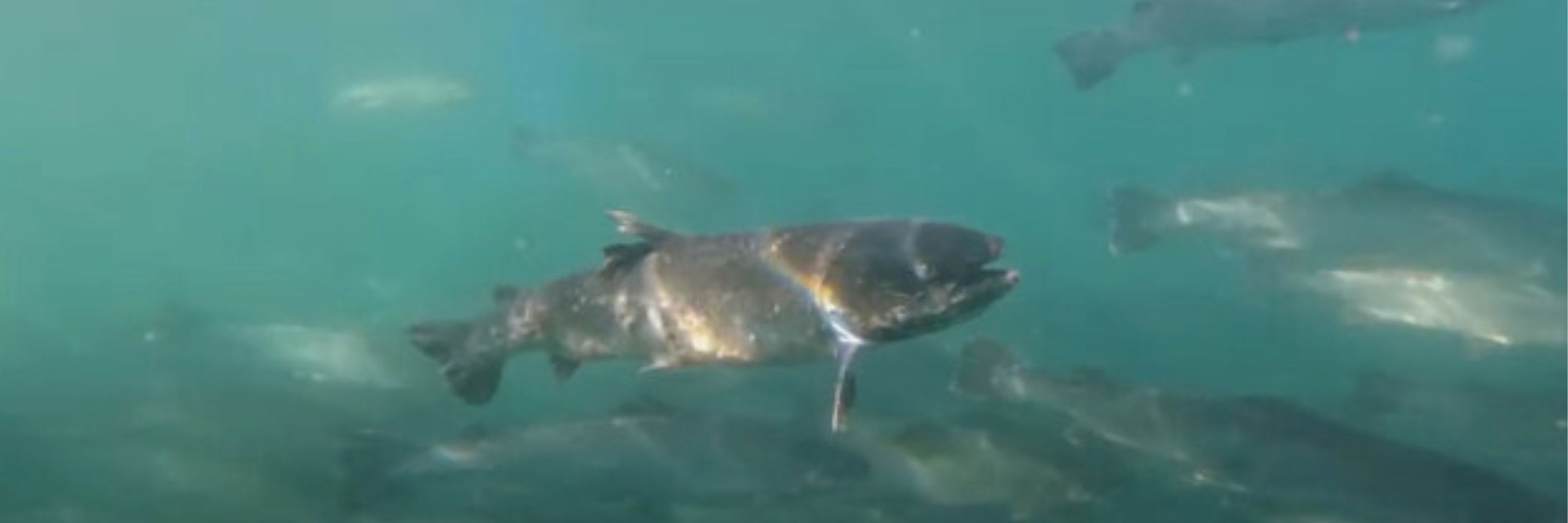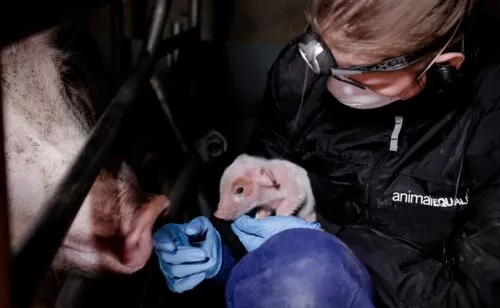Animal Equality analysis reveals hundreds of lice breaches on Scottish salmon farms


Animal Equality analysed lice infestations across Scottish salmon farms and found that almost one-quarter of active farms are in breach of the industry’s own lice Code of Good Practice at any moment in time.
Why do lice exist on salmon farms?
Atlantic salmon are naturally migratory animals that would travel many miles in the wild. While lice occur naturally, they are typically pushed off the salmon as they swim upstream and against the water. In underwater sea cages, the unnatural and crowded confinement makes for a perfect breeding ground for lice and disease outbreaks.
Lice infestations are common on salmon farms, where they eat away at the flesh of the live salmon. We have discovered farmed salmon with hundreds of lice over their face and body, causing immense pain; as a result, many farmed fish have sensitive, tissue-like skin that has been eaten away, sometimes to the bone.
The Scottish Government and regulators monitor the presence of female lice specifically, since the females carry the eggs and breed. However, the smaller male lice are also highly distressing to the farmed salmon.
Lice: harmful to farmed and wild fish
In late 2024, the Scottish Parliament’s Rural Affairs and Islands Committee conducted a nine-month inquiry into the Scottish salmon farming industry, following a similar inquiry in 2018, prompted due to environmental concerns posed by the industry.
Salmon farming is highly controversial – both because of the scale and severity of suffering that it causes to migratory Atlantic salmon, but also because of the destruction that it causes to the wider environment. Atlantic salmon are carnivorous, so the industry captures huge numbers of wild fish from the ocean to use as feed; a single farmed salmon consumes around 440 smaller wild-caught fish in their lifetime, and many millions of salmon die on-farms along the way from disease and lice outbreaks, predation, rough weather, or violent industry ‘treatments’. The industry uses antibiotics and toxic chemicals in an attempt to manage the lice and disease that are rife on salmon farms, which spread from the nets onto the seabed and sea lochs.
Sea lice that spread within the farms also pose a potentially serious risk to wild salmon and sea trout. The young fish are especially vulnerable to sea lice, which can weaken them, reduce their ability to adapt to marine life, and impact their survival. The Rural Affairs and Islands Committee recognised this during its inquiry, recommending that the Scottish Government takes a precautionary approach.
The salmon farming sector has its own ‘Code of Good Practice’, with a suggested level for the treatment of sea lice on individual farm sites of an of 0.5 adult female lice per fish during what is called ‘the sensitive period’ 1st February – 30th June.
Over 600 breaches during the ‘sensitive period’
Despite this, we discovered hundreds of weekly breaches, many during the very months when young wild salmon and trout are migrating from rivers to sea – their most vulnerable life stage. In 2025, during the sensitive period alone, there were 623 weekly reports where lice counts exceeded the 0.5 threshold. There were also 464 instances where no count was carried out.
All four of the major salmon farm companies operating in Scotland had sites where counts repeatedly went well above the threshold:
- Scottish Sea Farms, Dunstaffnage farm: every weekly lice count between February-June was above the permitted threshold, except two
- Cooke Aquaculture, Chalmers Hope farm: every weekly lice count was above the permitted threshold during the sensitive period
- Bakkafrost, Gob a Bharra farm: lice counts went over the threshold for 12 weeks, peaking at a level nearly eight times above it in June
- Mowi, Loch Leven farm: this farm saw a highest count of 7.7 in June, over 15 times higher than the threshold
Industry blocking new lice requirements
Earlier this year, Scottish environmental regulator ‘SEPA’ issued ‘variation of authorisation’ notices to a number of farms, declaring that from late March a farm-specific limit on the number of adult female sea lice would form part of the site’s licence conditions.
The change is part of its Sea Lice Regulatory Framework, designed to reduce the impact of sea lice from fish farms on migrating wild salmon. But, in response, the Scottish salmon industry issued 210 appeals to the Scottish Government planning appeals division, swamping the planning system and opposing all the new measures. As a result, the requirements have been paused until the appeals have been processed.
We hold the power
The Scottish salmon industry is riddled with problems – lice is just one of many issues hidden underwater.
If you too are rightly concerned, please boycott salmon and other animal products today. Try out our free cookbook today and enjoy plant-based instead!
And join us in calling for a halt to the industry’s expansion. We cannot allow the Scottish salmon industry to continue its deadly and unchecked expansion:






